We all know that the automobile replaced the horse as the primary means of transportation in America. When it came to pulling heavy loads, draft animals such as oxen, mules, and horses also gave way to the truck. In those early days, nobody made a tougher truck than Mack Trucks. Built of the finest components, these rugged vehicles handled payloads far above their rating and did so for decades. Trucks like this 1930 Mack AC for sale on Facebook Marketplace in Sturgis, South Dakota were slow, difficult to drive, and looked like antiques even when they were new. This example spent much of its life in the service of a gold mine and was modified heavily to keep it on the road for as long as possible. Now in rough but possibly restorable shape, this chain-driven beast of burden is being offered for $5,000. Is that a reasonable sum for one of the few survivors of this once plentiful truck? Thanks to Howard A. for suggesting this early heavy hauler!
My great-grandfather was a storyteller. One of his often-repeated tales was seeing the first car in his hometown as a boy. He also lived to see the moon landings and the first space shuttle launch. It is amazing to look back on his life and think of all the changes he saw. The great leap forward in history that the last century brought us is mind-boggling compared to all of the history recorded before that. You could also make the argument that the technological advances we have seen since the year 2000 have the potential to be even more startling. When you look at specific areas, that technological progression is easier to analyze.
A great example would be to look at the history of heavy-duty trucks in general, and Mack Trucks in particular. Leaving the horse behind was as essential to transportation’s progress. However, the early 1900s found horses in abundance in the streets of America’s great cities. With the benefits of their labor came the drawbacks of waste, storage, care, and feeding of these beleaguered beasts. As the internal combustion engine was developed, planners looked to it to solve the problems of moving heavy loads from place to place. Early trucks were evolutions of horse-drawn wagons with bodies designed for the load they carried. Wood in the framework gradually gave way to steel. Compare this Mack to a 2025 model and you can see just how incredible the advance in technology has been for something as pedestrian as a heavy-duty truck.
The 1930 Mack AC you see here represents the roots of the gradual evolution of heavy trucks. The AC model was introduced in 1918 and was produced until 1938. Variations of the AC were used extensively during World War I by the United States and its allies. The British loved the distinctive design of this heavy hauler and dubbed it the “Bulldog.” Mack seized on this nickname and used the image of an actual bulldog as a marketing tool that is still in use today. Everything about this truck is built for heavy service. From the massive steel frame to the chain drive and solid rubber tires, the build of this truck tells us all we need to know about how and when it was built. The solid rubber tires and chain drive tell us that the loads carried by this truck were substantial for the time. With no air in the tires, there was no chance of a heavy load causing a blown-out tire. The chain drive was a clue that forward speed was sacrificed to increase the weight of the truck’s potential load. Examining the frame and body, one can see that saving weight wasn’t even considered when designing it. Everything is built heavy for durability and strength. At the time, metallurgists didn’t have access to all the magnificently strong yet lightweight steels we enjoy today. To make a piece of metal stronger, your best option was to increase the amount of metal per part.
This 1930 Mack AC, lived a hard life. It was one of six Macks purchased by the Homestake Gold Mine in 1930 to do the heavy hauling required in the mining industry. From there it went to a fellow who used it to transport logs to a sawmill. Along the way, it was repaired and modified with parts that were available and economical to use. The seller tells us that the engine is an International 233, and the transmission is a “high speed” type with 17 forward gears and reverse. The truck must have been involved in a wreck of some sort. The front-end sheet metal has been replaced. Gone are the distinctive Mack hood and hood sides. In their place are an Oliver Baglow hood, hood sides from a Studebaker, and an owner-fabricated Mack logo attached to the front. The truck will come with an extra drive shaft, a rear axle with tires, and an extra transmission.
Sadly, this elderly Mack is not currently running. It would have been nice to know if the transplanted powerplant still rotates freely, but that information was not included in the ad. The engine we see in the picture above appears to have been produced in the thirties or forties. Perhaps one of our readers can give us more background into its pedigree and that of the 17-speed transmission. It is surely more powerful than the original engine and would make driving this archaic truck a very interesting experience.
The seller suggests that this would make a great rat rod. As impractical as rat rods can be, it might be a bridge too far to make a solid tire truck with chain drive into one. The sad thing is that, aside from being a parts donor, there aren’t too many options available to the next owner. Making a street rod out of it is feasible, but would also require a lot of changes to what makes this truck unique in the first place. Perhaps getting it to run and drive would be sufficient. Every modification tells the story of a truck that did a tremendous amount of hard work during its service life before it was finally too obsolete to continue. It deserves more dignity than being chopped up and modified for shock value.
What would you do with this Mack? Do you think there is enough there to return it to running and driving condition? When was the last time you saw a solid tire truck? Please share your opinions and memories in the comments.

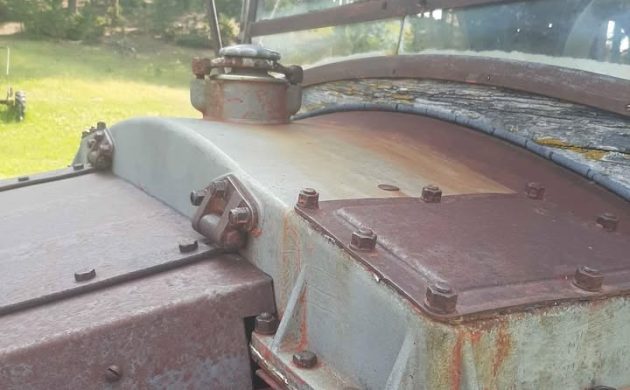
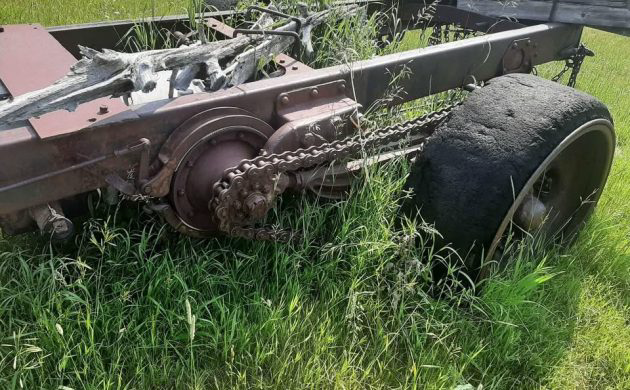

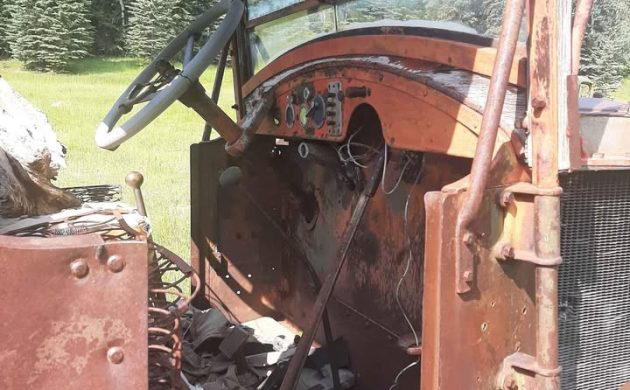
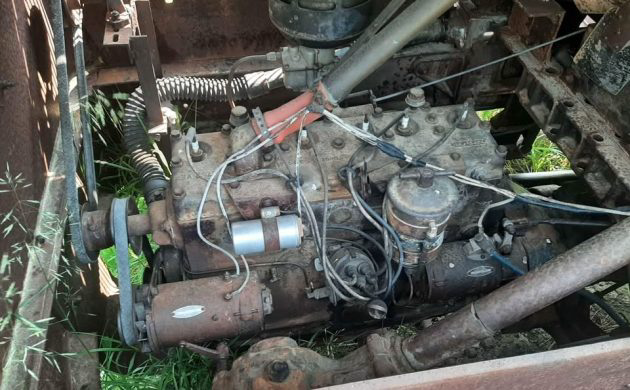



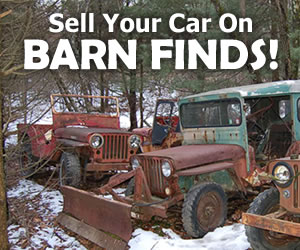
5k? Nope!…..Scrap?…..Yes!
Sometimes it’s just time to say good-bye. Steel’s about 8-cents a pound these days.
I was glad that Howard A. Found this, and Jeff wrote it up. Jeff, you did a lot of research on this and it shows, you did a great write up. Even figuring out the front tin work where it came from, and non original engine and trans. This is what people did “back in the day” to keep something going. 6 decades ago, they weren’t worried about keeping the old Mack “numbers matching”. But if the frame was good, and you had the parts and ability, people prided themselves on keeping an old truck going a few more years. It’s going to take a lot of work to get this going again. If that’s whats going to happen.
If you stop and think about it, look how far, and how much has changed in the trucking industry over the last hundred years. Today, someone might look at a B model Mack from the 50’s with twin sticks and manual steering and say Dear Lord, how did they drive this thing every day back then, but just think about the guy who was driving an open cab Mack like this in all the elements, snow, rain, heat, and was handed the key to that brand new B Model Mack, what a step up in the world that must’ve been. And now, the new trucks are like luxury liners compared to that. Sorry for the long post, but I enjoyed this write up. Thank you. Keep them coming.
Thanks Dave, you know, I participate on a truckers site( The Truckers Report) and I try and bring up old school and falls primarily on deaf ears. It’s as if they simply take power steering, A/C, 500 HP motors and automatics for granted. Not sure drivers went from these to B models. Maybe these to the E series( 1938-1951), and then the B, but even still, the E was a stark improvement over the “C” cabs.
Howard, you’re absolutely right, I didn’t even think of the Model E. Those also had those new fangled roll up windows, etc. That would’ve been a better example. I was thinking ’38 ( end of the AC) to ’53 ( B model) 15 years. But the E is more realistic time wise. Thank you for mentioning that. And I hope they write up the Model R post…..
Hint……Hint….HINT…..
No cup holders? I am out.
17 forward gears Gracie? As much as I love old trucks all you got here is a glider kit with out a cab. Parts doner at best. Sorry.
I know it’s a classic Mack even if a long way from original form. Does the engine turn over? What’s the most viable use case? I’d get it running or nobody’s gonna care…
Bone Chilling Work
My father-in-law drove one of these with chains and plow in the little town of Orange, PA in the 1950’s. Can still remember the stories of what a beast it was to drive. Also said that no amount of snow could stop it though once it got going. This was in the 1970’s and I could only imagine what it must have been like in a blizzard with no doors or side windows to block the snow and wind!!!
A top speed of 30 mph (maybe) and you’ll have to shift 17 gears to get there. Those dudes were tough. Even the old schoolers I’ve met over the years never drove something this tough. They all had doors at least.
I knew an Old Timer whos Dad drove one of these. He said they were governed, and about 18 MPH was about it with the governor. It was probably an older one than this .
testing
Okay then, a huge thanks to Jeff, I kind of forgot about this one. I submitted 2 Macks at the same time, this and a R model that may come up, I hope. I didn’t even notice it had a different hood, and most of these rear radiator trucks look the same anyways. And why did they do that? Couple reasons, 1, vandalism was rampant. Owners of “Old Dobbin” didn’t look too kindly on these motorized monsters, and radiators took a toll. 2, the trucks didn’t go fast enough to cool the motor, so a reverse fan was employed. It must have worked. Chain drive too, why was that? I read, like mentioned, metal quality was in its infancy, and long axle shafts broke repeatedly. Therefore, a chain, the strongest way of distributing power, was used. Believe it or not, I think it was Kenworth that still offered chain drive into the 60s. Tires too, while it’s true, solid tires didn’t need air, it was not uncommon for tires to lose big chunks, and try riding THAT out all day. Like that shopping cart with the flat wheel I always get, only times 100. 17 speeds? Nah, maybe a 4 speed gear grinder main and perhaps a gear grinding 4 speed Brownie, plus reverse=17, but unlikely all were used. This truck sure is a cobbled job, and as mentioned, very typical of the mindset then. I’m not sure what to do with it, yard art, really, but for an enthusiast with these laying around, you know who you are, the parts here are priceless, never to be seen again.
Thanks Jeff for an excellent writeup, and as usual, thanks to the staff for my kooky submissions. Now, about that R model Mack???
Hey Howard, the ad says 17 speed, the only thing I could think of was somebody stuffed a quad box in it.
I can appreciate the comment on driving something like this having driven a ’33 Diamond T winch truck for a couple years as a 100 lb kid. Steering wheel was half my height and driving was like present day working out.
The father of an early skipper of mine was a real OG when it came to all things motors. He used to maintain Packard engines as transplanted into rum runners on the NJ coast.
He said that as a kid, he and his crew used to put telephone books or short pieces of wood on the drive wheels, so that as the truck rolled, the jam between the wheel and chain would pop the chain off the gears.
Total miscreant!
What’s a phone book???
When I was younger and living in Manchester, NH., the local MACK dealer, now Ballard Truck Center, headquartered in Worcester, MA. had several restored vintage C-cab trucks, particularly MACKS, as parade vehicles. If they still do that, they may be interested in it for parts.
In the mid ’50s, I regularly saw these ol’ Mack Bulldogs, solid or pneumatic tired, toddling around West Street in lower Manhattan. Fearsome beasts! There was a lot of ship cargo transferred to land-based means and these things were, in many cases, the first link to their destination, probably by rail.
Why was I there? I worked in the Wall Street area and rode Erie ferries and trains to my home in northern Bergen County, NJ. The mile from the office to the docks and Erie’s ferry terminal at Chambers Street was, for a good bit, beneath the West Side Highway, “the big umbrella,” long since replaced by the WTC.
Dating myself, aren’t I?
Hallamore Crane Service and Heavy Hauling has one of these on inside display at their crane division in Holbrook MA. They have a all Mack fleet. They have preserved a number of old Macks. Nice of them to preserve this interesting old truck. Looks great in company orange and white.
Believe it or not, I have one of these! Or at least very similar. Ill need to take a photo and post. It was originally used to build the Panama canal, and when done with that a bunch of them were brought to Oregon to work in the woods. My sawmill still has most of the original equipment and this is part of it.
So much is missing from this it hardly resembles a Mack anymore. The engine it totally wrong, the original is a lot more interesting. I’d love to have it for the parts, but even the cost of transport would be too much.. I don’t know where the 5K value comes from… But really it has no value and should be donates to someone that needs parts. Scrapping it would be a shame. Even mine, which is much more complete, would take someone like Jay Leno to restore because parts would need to be built from scratch.
Cool post, thanks Howard and Jeff.